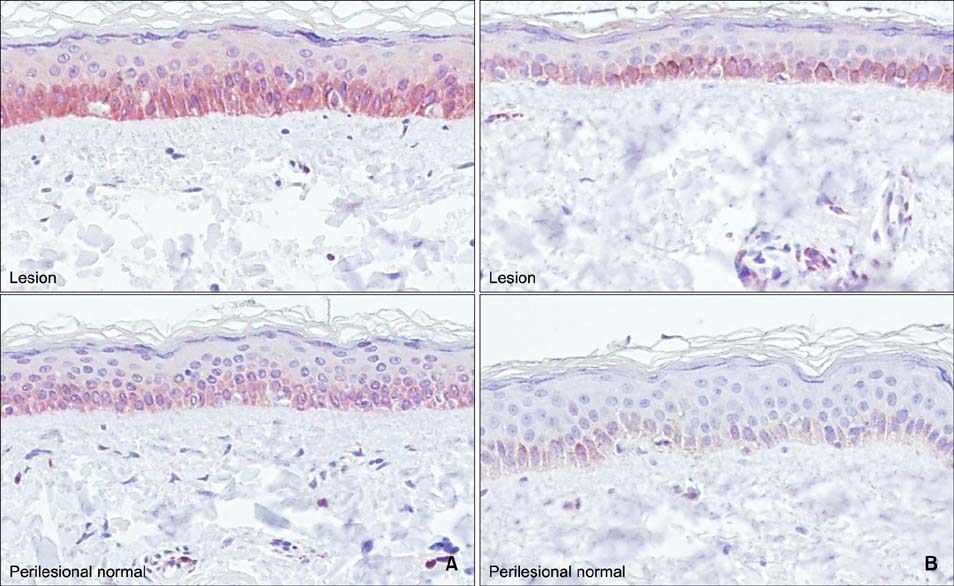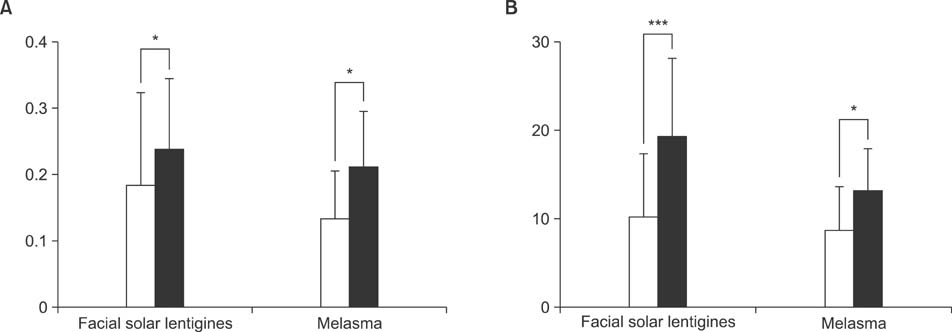Ann Dermatol.
2015 Oct;27(5):626-629. 10.5021/ad.2015.27.5.626.
Possible Involvement of Keratinocyte Growth Factor in the Persistence of Hyperpigmentation in both Human Facial Solar Lentigines and Melasma
- Affiliations
-
- 1Shiseido Research Center, Yokohama, Japan.
- 2Department of Dermatology, Graduate School of Ajou University, Ajou University School of Medicine, Suwon, Korea. hykang@ajou.ac.kr
- 3Department of Biomedical Science, Graduate School of Ajou University, Ajou University School of Medicine, Suwon, Korea.
- 4Chronic Inflammatory Disease Research Center, Ajou University School of Medicine, Suwon, Korea.
- KMID: 2171471
- DOI: http://doi.org/10.5021/ad.2015.27.5.626
Abstract
- No abstract available.
MeSH Terms
Figure
Cited by 1 articles
-
Skin Pigmentation and Pigmentary Disorders: Focus on Epidermal/Dermal Cross-Talk
Emanuela Bastonini, Daniela Kovacs, Mauro Picardo
Ann Dermatol. 2016;28(3):279-289. doi: 10.5021/ad.2016.28.3.279.
Reference
-
1. Gilchrest BA. Molecular aspects of tanning. J Invest Dermatol. 2011; 131:E14–E17.
Article2. Hodgson C. Senile lentigo. Arch Dermatol. 1963; 87:197–207.
Article3. Kang HY, Ortonne JP. What should be considered in treatment of melasma. Ann Dermatol. 2010; 22:373–378.
Article4. Finch PW, Rubin JS, Miki T, Ron D, Aaronson SA. Human KGF is FGF-related with properties of a paracrine effector of epithelial cell growth. Science. 1989; 245:752–755.
Article5. Chen N, Hu Y, Li WH, Eisinger M, Seiberg M, Lin CB. The role of keratinocyte growth factor in melanogenesis: a possible mechanism for the initiation of solar lentigines. Exp Dermatol. 2010; 19:865–872.
Article6. Lin CB, Hu Y, Rossetti D, Chen N, David C, Slominski A, et al. Immuno-histochemical evaluation of solar lentigines: The association of KGF/KGFR and other factors with lesion development. J Dermatol Sci. 2010; 59:91–97.
Article7. Hirobe T, Hasegawa K, Furuya R, Fujiwara R, Sato K. Effects of fibroblast-derived factors on the proliferation and differentiation of human melanocytes in culture. J Dermatol Sci. 2013; 71:45–57.
Article8. Iriyama S, Ono T, Aoki H, Amano S. Hyperpigmentation in human solar lentigo is promoted by heparanase-induced loss of heparan sulfate chains at the dermal-epidermal junction. J Dermatol Sci. 2011; 64:223–228.9. Lee DJ, Park KC, Ortonne JP, Kang HY. Pendulous melanocytes: a characteristic feature of melasma and how it may occur. Br J Dermatol. 2012; 166:684–686.
Article10. Torres-Álvarez B, Mesa-Garza IG, Castanedo-Cázares JP, Fuentes-Ahumada C, Oros-Ovalle C, Navarrete-Solis J, et al. Histochemical and immunohistochemical study in melasma: evidence of damage in the basal membrane. Am J Dermatopathol. 2011; 33:291–295.
Article
- Full Text Links
- Actions
-
Cited
- CITED
-
- Close
- Share
- Similar articles
-
- Melasma
- Clinical Study of Facial Melanosis
- The Expression of Fibroblast-derived Cytokines in Melasma
- A Split-Face, Single-Blinded, Randomized Controlled Comparison of 532 nm Picosecond Neodymium-Doped Yttrium Aluminum Garnet Laser versus 532 nm Q-Switched Neodymium-Doped Yttrium Aluminum Garnet Laser in the Treatment of Solar Lentigines
- Four Cases of Unusual Pigmentation after UVB Phototherapy for Psoriasis



